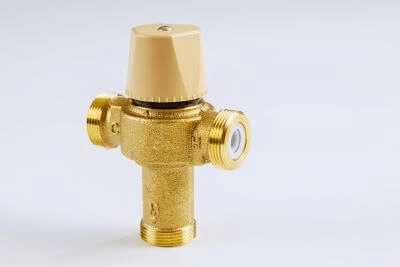What Is a Mixing Valve?

A mixing valve is a temperature control valve that adjusts hot water temperature by mixing hot and cold water. These valves are traditionally used in gas and electric water heaters, and more recently in CO2 natural refrigerant heat pump water heaters, known as Eco-Cute, in all-electric houses.
By simply connecting hot and cold water supplies, these valves can easily provide water at a desired temperature. They also perform well under varying water pressure conditions, ensuring consistent hot water temperature.
Mixing Valve Applications
Mixing valves have a wide range of applications:
1. Shower Faucets
Commonly used in shower systems, mixing valves adjust the water temperature by blending hot and cold water, providing a comfortable shower experience.
2. Water Faucets
They are essential in household fixtures, such as bathtubs, washbasin faucets, and washing machine water outlets, for delivering water at a user-friendly temperature.
3. Heating Systems
In heating systems like floor heating and radiators, mixing valves blend hot and cold water to supply water at the required temperature.
4. Food and Painting Industries
In the food industry, these valves accurately mix ingredients for beverages and in the production of seasonings and sauces. In the painting industry, they ensure consistent mixing of colors and compounds.
Mixing Valve Principle
Mixing valves control fluids from multiple inlet ports, often mixing fluids of varying temperatures and pressures.
An internal mechanism, such as a valve plug, controlled by a handle or lever, adjusts the fluid flow. The mixing chamber within the valve blends the fluids from the inlets, outputting a mixed fluid at a specific ratio and temperature. These valves can maintain consistent output pressure even with fluids of different input pressures.
How to Select a Mixing Valve
Consider the following when selecting a mixing valve:
1. Pressure Resistance Performance
Choose a valve based on the maximum pressure it can withstand. High-pressure resistance valves typically cost more and have larger connection ports.
2. Material
Valves are usually made of metal, with options like bronze, stainless steel, and cast iron. Bronze, a copper and tin alloy, is cost-effective and easy to work with. Stainless steel offers high corrosion resistance and durability, while cast iron is cost-effective but less corrosion-resistant.
3. Heat Resistance Temperature
Most mixing valves are designed for hot water use, with a typical heat resistance of about 90°C. Also, consider the settable temperature range, which varies depending on the input fluid’s temperature.
4. Connection Diameter and Method
Choose the appropriate connection diameter and method for your application. Common methods include flange and screw connections, with flange connections typically measured in millimeters and screw connections in inches.